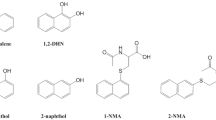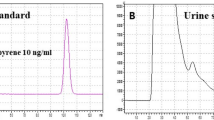Abstract
Objectives: To compare blood toluene (TOL-B) and urinary toluene (TOL-U) as biomarkers of occupational exposure to toluene, and to set a suitable procedure for collection and handling of specimens. Method: An assay based on headspace solid-phase microextraction (SPME) was used both for the determination of toluene urine/air partition coefficient (λurine/air) and for the biological monitoring of exposure to toluene in 31 workers (group A) and in 116 non-occupationally exposed subjects (group B). Environmental toluene (TOL-A) was sampled during the work shift (group A) or during the 24 h before specimen collection (group B). Blood and urine specimens were collected at the end of the shift (group A) or in the morning (group B) and toluene was measured. Results: Toluene λurine/air was 3.3 ± 0.9. Based on the specimen/air partition coefficient, it was calculated that the vial in which the sample is collected had to be filled up to 85% of its volume with urine and 50% with blood in order to limit the loss of toluene in the air above the specimen to less than 5%. Environmental and biological monitoring of workers showed that the median personal exposure to toluene (TOL-A) during the work-shift was 80 mg/m3, the corresponding TOL-B was 82 μg/l and TOL-U was 13 μg/l. Personal exposure to toluene in environmentally exposed subjects was 0.05 mg/m3, TOL-B was 0.36 μg/l and TOL-U was 0.20 μg/l. A significant correlation (P < 0.05) was observed between TOL-B or TOL-U and TOL-A (Pearson's r=0.782 and 0.754) in workers, but not in controls. A significant correlation was found between TOL-U and TOL-B both in workers and in controls (r=0.845 and 0.681). Conclusion: The comparative evaluation of TOL-B and TOL-U showed that they can be considered to be equivalent biomarkers as regards their capacity to distinguish workers and controls and to correlate with exposure. However, considering that TOL-U does not require an invasive specimen collection, it appears to be a more convenient tool for the biological monitoring of exposure to toluene.
Similar content being viewed by others
Author information
Authors and Affiliations
Additional information
Received: 20 October 1999 / Accepted: 4 March 2000
Rights and permissions
About this article
Cite this article
Fustinoni, S., Buratti, M., Giampiccolo, R. et al. Comparison between blood and urinary toluene as biomarkers of exposure to toluene. Int Arch Occup Environ Health 73, 389–396 (2000). https://doi.org/10.1007/s004200000156
Issue Date:
DOI: https://doi.org/10.1007/s004200000156




